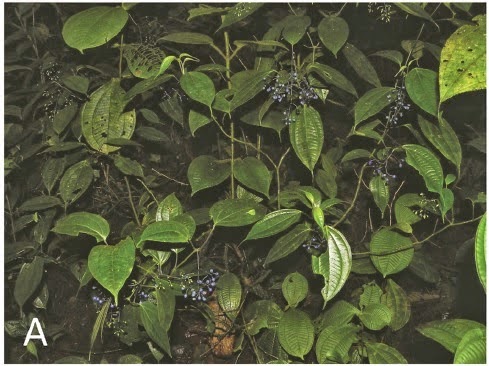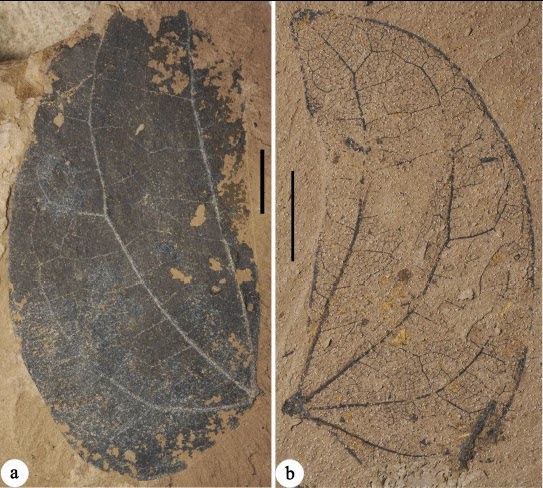The Domestic Tree Peony, Paeonia
suffruticosa, has a long history of cultivation in China, where
records of the plant growing in gardens go back at least 1400 years. Domestic
Tree Peonies are noted for their beauty and fragrance, and are known as the
‘King of Flowers’ in China.
However the precise origin of the domestic Tree Peony is obscure, with most
experts believing that it is a hybrid of two or more of the wild Tree Peony
species found in China,
but with no consensus as to which plants might be involved.
In a paper published in the Proceedings of the Royal Society: SeriesB, Biological Sciences on 5 November 2014, a team of scientists led by Shi-Liang
Zhou of the State Key Laboratory of Systematic and Evolutionary Botany at the Institute of Botany
at The Chinese Academy of Sciences describe the results of a genetic study of Paeonia suffruticosa and the nine wild
Tree Peony species found in China,
in order to determine the relationships of the domestic plant.
The ‘King of Flowers’, Paeonia suffruticosa, at Prague Botanic Garden. Karel Jakubec/Wikimedia Commons.
Zhou et al. found that Paeonia suffruticosais a hybrid of at
least five wild species, Paeonia cathayana,
Paeonia rockii, Paeonia qiui, Paeonia ostii
and Paeonia jishanensis, with most of
the cultivars obtained by hybridizing female Paeonia cathayana flowers with males of another species, though
sometimes other plants had been used as the female, and many cultivars had been
achieved by further hybridization.
Zhou et al. further note
that all the wild Tree Peony species involved come from central China, the area
in which the domestic plant was first cultivated, and that the majority are now
rare or endangered. In particular they note that only a single specimen of Paeonia cathayana, the species that
appeared to contribute the most to the origin of the domestic plant, could be
found growing in the wild, in the mountains to the south of Louyang. Paeonia ostii also seemed to be reduced to
a single wild specimen, this time on a cliff in central Anhui
Province, and Paeonia qiui was found only in a handful of small populations in western
Hubei Province. Paeonia jishanensis still has several relatively large populations,
but this species is known to reproduce vegitatively (non-sexually), so it is
unclear how genetically diverse these populations are (low genetic diversity
populations can be extremely vulnerable to disease, and apparently large and
healthy populations are sometimes wiped out suddenly). Only one species, Paeonia rockii, is still relatively
widespread, being found across a large area of central and western China, but
this is widespread population is largely composed of widely scattered very
small populations and individuals, making this species also vulnerable.
The distribution of nine wild tree peony species. (1) Paeonia ludlowii; (2) Paeonia delavayi; (3) Paeonia decomposita; (4) Paeonia rotundiloba; circle, Paeonia rockii; diamond, Paeonia jishanensis; square, Paeonia ostii; triangle, Paeonia qiui; hexagon, Paeonia cathayana. Zhou et al. (2014).
Approximately one tenth of the dry land surface of the Earth has now
been converted to agricultural purposes by Humans, and that while this has
benefitted us enormously, it has come at great cost to many wild species, particularly
the progenitors (wild ancestors) of most of our crops, which for the most part
formerly grew in the best areas for growing their domestic relatives. This is
known to present food security problems for Human populations, as domestic
crops tend to be less genetically diverse and therefore more vulnerable to
disease than their wild relatives, and the loss of these wild relatives reduces
the available genetic diversity that might be needed to breed crops resilient
to as yet unknown threats. Zhou et al. observe
that in addition to this known problem with agricultural plants, the widespread
cultivation of ornamental plants in parks and gardens presents an additional
threat to biodiversity, that should also be a focus for botanists and
conservationists.
See also…
 The impact of an invasive native shrub on semi-arid cattle rangelands in Zimbabwe.
The impact of an invasive native shrub on semi-arid cattle rangelands in Zimbabwe.
The term ‘invasive species’ is most commonly associated with species
which have been introduced to new areas by human activity (such as Eurasian
species in Australia), but also applies to species that have been able to
expand to new areas within their native ranges...
Bush Currants, Miconieae, are berry producing tropical trees and
shrubs in the Melanastome Family, Melastomataceae. They are found throughout
the tropics but at their most diverse in Colombia, where over 490 species
have been described.
The Legumes are one of the most successful groups of modern plants, with
over 19 000 described species; over 9% of all known Dicots are Legumes.
The group owe their success largely to the presence of symbiotic
nitrogen-fixing Bacteria in their roots, which enable Legumes to thrive
in nutrient-poor soils. The group...
Follow Sciency Thoughts on Facebook.




